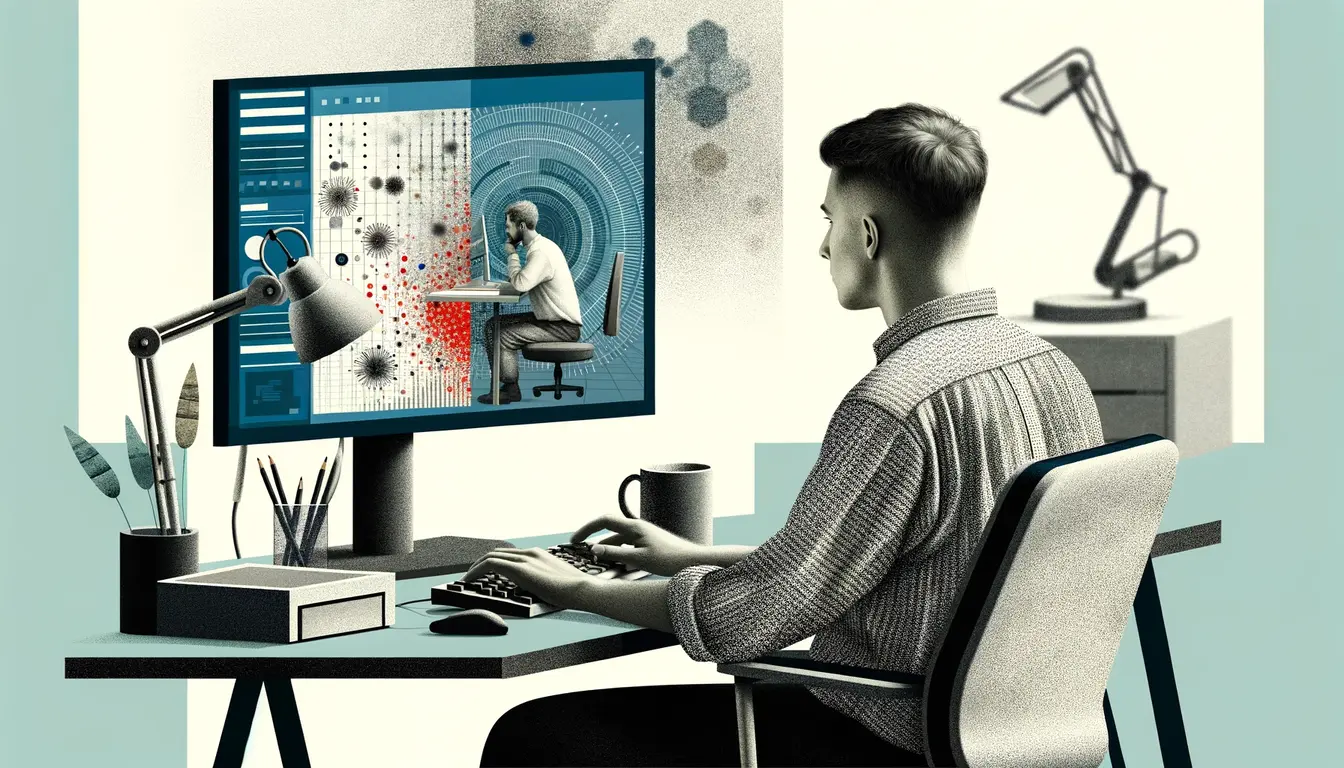Introduction
We are witnessing a silent epidemic creeping its way into the lives of young adults across the globe: back pain. Once thought to be a problem reserved for the elderly or those with physically demanding jobs, back pain has now become an unwelcome companion for many young individuals. Understanding the main causes of back pain in young adults and how to prevent it is crucial to addressing this widespread issue.
Whether you’re a student glued to your computer screen for hours on end, a professional chained to your desk, or simply someone caught up in the hustle and bustle of modern life, chances are you’ve experienced the nagging twinges or debilitating spasms of back pain at some point. This insidious condition not only affects our physical well-being but also takes a toll on our mental health and overall quality of life.
The Prevalence and Impact of Back Pain in Young Adults
It’s time we shed light on this often-overlooked issue and address it head-on. The prevalence of back pain among young adults is alarming, yet so many suffer in silence, believing it’s just a normal part of life.
Back pain is a common ailment that affects a significant portion of the population, particularly young adults. Recent data indicates that 28.4% of adults aged 18–29 experience back pain. This prevalence is noteworthy as it highlights a condition often associated with older age groups, now impacting a younger demographic.
Understanding the causes of back pain in young adults is crucial for several reasons. Firstly, it can lead to early intervention and prevent the development of chronic conditions that could impair quality of life. Secondly, it can help young adults make informed lifestyle choices that could mitigate the risk of developing back pain. Lastly, recognizing the causes can guide healthcare professionals in creating targeted treatments and support systems for this age group.
Back pain in young adults can stem from a variety of factors, ranging from physical injuries and lifestyle habits to psychological stressors. By delving into these causes, we can begin to examine the complex interplay between our daily activities, mental health, and physical well-being. As we explore the main causes of back pain, we aim to empower young adults with the knowledge to take proactive steps toward managing their health and maintaining a back without pain.

Common Causes of Back Pain in Young Adults
Muscle or Ligament Strain: Repeated heavy lifting or sudden, awkward movements can strain back muscles and spinal ligaments. The consistent overuse of these muscles can lead to muscle spasms and may contribute to back pain if not properly managed. Prolonged repetitive movement, overstretching, or excessive muscle contraction are common causes of muscle strain.
Preventative measures include regular stretching and strengthening exercises, maintaining good posture, and avoiding sitting in one position for too long.
Bulging or Ruptured Disks
Disks act as cushions between the bones (vertebrae) in your spine. The soft material inside a disk can bulge or rupture and press on a nerve, leading to back pain. This condition is more likely to occur due to wear and tear, although it can also result from a traumatic event. Muscle numbness and weakness may also accompany herniated disk pain in the back, arm, leg, and foot.
Arthritis and Osteoarthritis
can affect the lower back. In some cases, arthritis in the spine can lead to a narrowing of the space around the spinal cord, a condition called spinal stenosis. Arthritis is more common in middle-aged and older people but can also occur in young adults. Factors such as gender, genetics, and excess weight can contribute to the development of arthritis in young adults.
Osteoporosis
Young adults can experience osteoporosis, a condition that weakens bones and makes them more likely to fracture. Vertebral fractures due to brittle bones are a risk associated with osteoporosis. True osteoporosis in young adults is defined as a T-score below −2.5 at the spine or hip associated with a chronic disease known to affect bone metabolism.
Ankylosing Spondylitis
This type of arthritis causes chronic inflammation of the spine and sacroiliac joints, leading to pain and stiffness in the lower back and hips. It typically affects young adults and can result in the gradual fusing of the vertebrae, leading to a loss of flexibility and a hunched posture.
Regular exercise, maintaining proper posture, and avoiding smoking can help manage the symptoms.
Lifestyle Factors Contributing to Back Pain
Lack of Exercise and Its Impact on Back Health A sedentary lifestyle can significantly contribute to back pain in young adults. Regular physical activity is essential for maintaining the strength and flexibility of the muscles that support the spine. Without it, these muscles can weaken, leading to poor posture and increasing the risk of injury and pain.
Studies have shown that low levels of physical activity in young people are linked to increased rates of obesity, cardiovascular disease, and poor mental health. Moreover, a non-significant trend suggests that increased leisure-time physical activity may reduce low back pain, although the protective effect against back pain is not conclusively supported.
The Role of Excess Weight in Back Stress Carrying excess weight, particularly around the midsection, can put additional stress on the back muscles and ligaments. Back pain can result from the spine’s inability to evenly distribute the body’s weight when this balance is upset.
Due to the excessive stress that weight gain causes, the smaller joints in the spine known as facet joints may inflame, resulting in persistent back pain. Furthermore, for every pound of extra weight, the spine is burdened with an additional load, which can lead to anatomical changes in the spine’s alignment.
Consequences of Poor Posture During Daily Activities Poor posture, whether while sitting, standing, or moving, can have a detrimental effect on back health. Slouching or hunching over can strain the muscles and ligaments in the back, leading to pain and discomfort.
Over time, poor posture can lead to chronic conditions such as back, neck, and shoulder pain, spine curvature or misalignment, muscle fatigue, and joint degradation. It is essential to maintain a neutral spine position and to make adjustments to workstations and daily habits to support good posture.

Injury-Related Causes
Sports Injuries and Their Long-Term Effects Sports injuries are a significant concern for young adults, with the potential to cause both immediate pain and long-term health issues. Injuries sustained during athletic activities can range from minor sprains to severe damage to muscles, ligaments, and bones.
One of the most concerning long-term effects of sports injuries is the development of osteoarthritis (OA), particularly in weight-bearing joints such as the hips, knees, and ankles. This is especially true for injuries associated with high-impact sports.
Additionally, injuries to the physis (growth plate) at a young age can lead to limb deformities and leg-length discrepancies, which may contribute to chronic back pain as the body compensates for the imbalance.
Accidents and Their Impact on the Spine Accidents, whether from vehicle collisions, falls, or other traumatic events, can have a profound impact on the spine. The force exerted during an accident can cause fractures, dislocations, and other injuries to the vertebrae and spinal cord.
These injuries can result in immediate and severe symptoms, including loss of sensation, muscle strength, and autonomic functions like bladder control. Long-term consequences may include chronic pain, reduced mobility, and even paralysis. The risk of spinal cord injury is particularly high in young adult males, who tend to have increased exposure to such accidents due to factors like sports participation and motor vehicle use.
Other Medical Conditions
Kidney–Related Issues Kidney-related issues, such as infections or stones, can manifest as back pain, often felt in the flank area or lower back. Pyelonephritis, a kidney infection, can cause excruciating back pain along with other symptoms like fever, chills, and urinary disturbances.
Kidney stones, on the other hand, can cause excruciating pain as they move through the urinary tract. This pain can start in the back and radiate to the abdomen and groin. The pain typically comes in waves and fluctuates in intensity as the stone moves.
Endometriosis Endometriosis is a condition where tissue similar to the lining of the uterus grows outside it, often affecting the pelvic region, which can lead to significant back pain in females. This pain is usually chronic and may worsen during menstrual periods.
Endometriosis can cause inflammation and may even lead to nerve compression if the tissue grows near the lower back, resulting in pain that can radiate to the pelvic area. Managing endometriosis and its symptoms often requires a multifaceted approach, including medication, surgery, and lifestyle adjustments.
Psychological Factors
Stress and Tension Leading to Muscle Tightness Stress is a common experience for many young adults, and it can have a direct impact on physical health, including the development of muscle tightness.
When stressed, the body’s natural response is to tense up as part of the “fight-or-flight” reaction, which prepares the body to respond to perceived threats. This tension often manifests in the back muscles, leading to discomfort and pain. Chronic stress can result in sustained muscle tension, exacerbating back pain, and potentially leading to other health issues.
The Connection Between Mental Health and Chronic Pain The relationship between mental health and chronic pain is well-documented. Chronic pain can significantly affect a person’s mental health, contributing to conditions such as depression and anxiety.
Conversely, existing mental health issues can intensify the perception of pain. Research shows that individuals with chronic pain are at a higher risk for developing mental health disorders, and those with mental health disorders may experience more severe and persistent pain. This bidirectional relationship highlights the importance of addressing both mental health and pain management in young adults suffering from back pain.

Dietary Habits and Their Impact on Back Health
Inflammatory Foods: Fueling Chronic Pain
Let’s talk about the silent saboteurs lurking in our daily diets—inflammatory foods. These sneaky culprits not only wreak havoc on our waistlines but also play a significant role in fueling chronic pain, including back discomfort.
Foods high in trans fats, refined sugars, and processed ingredients are like grenades going off inside our bodies, triggering inflammation that can exacerbate existing back issues. It’s time to ditch the convenient yet detrimental fast food and sugary treats that are only adding more fuel to the fire of back pain.
Impact of Poor Nutrition on Joint Health
Our joints are the unsung heroes of mobility, bearing the brunt of daily activities with each step we take. Yet, many young adults neglect the impact of poor nutrition on joint health, ultimately paying the price with nagging backaches.
When we deprive our bodies of essential nutrients like omega-3 fatty acids, antioxidants, and vitamin D through a diet laden with processed junk food, we’re setting ourselves up for joint deterioration and compromised spinal health. It’s time to prioritize whole foods rich in nutrients that support joint function and overall well-being.
Importance of Anti-inflammatory Diet for Managing Back Pain
Picture this: A plate filled with colorful fruits and vegetables bursting with antioxidants, lean proteins like salmon rich in omega-3, and wholesome grains offering fiber and vital nutrients—this is your ticket to managing back pain through an anti-inflammatory diet. By embracing foods that combat inflammation rather than promote it, you’re taking proactive steps toward alleviating discomfort in your back.
Let food be thy medicine and choose wisely to nourish your body from within. It’s time to make a conscious shift towards an anti-inflammatory diet that not only benefits your overall health but also serves as a powerful ally in the battle against back pain.
Rarely Known Causes That May Surprise You
Genetic Predispositions: Unveiling the Silent Contributors to Back Pain
Ah, behold the elusive factor that often lurks in the shadows of back pain discussions: genetic predispositions. Yes, it’s time we shed light on the hereditary elements that may be silently responsible for your back woes.
While you may diligently blame your poor posture or lack of exercise for those nagging aches, it’s crucial to recognize that your genes could also be playing a significant role in this intricate dance of discomfort. Examining your family history might just reveal a hidden narrative of spinal vulnerabilities passed down through generations.
Certain genetic variations can predispose individuals to conditions like degenerative disc disease or structural abnormalities that make them more susceptible to back pain at a younger age than expected. So, next time you feel those twinges in your spine, spare a thought for the genetic blueprint that may be influencing your back health more than you realize.

Prevention and Management
Tips for Maintaining a Healthy Back:
Maintaining a healthy back is essential for preventing back pain and ensuring overall spinal health. Here are some tips to help keep your back in good shape:
Exercise Regularly: Engage in activities that strengthen your core muscles, which support your spine. Include stretching to maintain flexibility.
Maintain Proper Posture: Be mindful of your posture when sitting, standing, and walking. Use ergonomic furniture and maintain the natural curve of your spine.
Lift Correctly: Use your legs, not your back, when lifting heavy objects. Keep the load close to your body, and avoid twisting while lifting.
Healthy Weight: Aim to maintain a healthy weight to reduce the strain on your back muscles and spine.
Quit Smoking: Smoking can impair blood flow, leading to disc degeneration and increased back pain.
Stay Active: Even when experiencing back pain, gentle movement and walking can help alleviate symptoms.
When to Seek Medical Attention
Back pain often resolves with self-care, but there are instances when medical attention is necessary.
Persistent Pain: If your back pain doesn’t improve after a week of home treatment, consider seeing a doctor.
Severe Pain: Seek immediate care if the pain is intense, especially at night or when lying down.
Neurological Symptoms: If you experience weakness, numbness, or tingling in your legs, it’s important to get medical help.
After an Injury: If your back pain follows a trauma like a fall or accident, see a doctor promptly.
Other Symptoms: Fever, unintended weight loss, or bowel/bladder control problems accompanying back pain should prompt a medical visit.
Conclusion
Throughout this article, we’ve explored the multifaceted causes of back pain in young adults, ranging from physical strains and injuries to medical conditions and psychological factors. We’ve seen how lifestyle choices, such as exercise and posture, play a pivotal role in either contributing to or alleviating back discomfort. For tips on maintaining an active lifestyle despite a busy schedule, check out our article on How to Stay Active and Fit with a Busy Schedule. We’ve also discussed in this article the importance of recognizing when to seek medical attention to prevent acute pain from becoming a chronic issue.
As we conclude, it’s essential to emphasize the significance of proactive back health management. Taking charge of your well-being isn’t just about responding to pain—it’s about preventing it. By incorporating regular exercise, maintaining a healthy weight, and practicing good posture, you can significantly reduce the risk of developing back pain. Regular check-ups and being attuned to your body’s signals are also crucial steps in staying ahead of potential health issues.
Remember, the power to maintain a healthy back lies in your hands. By being proactive, you can not only improve your current quality of life but also safeguard your future health. So, take the necessary steps today to ensure a strong and pain-free back for years to come.
FAQ’s
What are the main causes of back pain in young adults?
The main causes of back pain in young adults include muscle or ligament strain, bulging or ruptured disks, arthritis, osteoporosis, ankylosing spondylitis, poor posture, a sedentary lifestyle, excess weight, and stress.
How can poor posture lead to back pain?
Poor posture, such as slouching or hunching over, puts extra stress on the back muscles and spine, leading to pain and discomfort over time. Maintaining a neutral spine position and using ergonomic furniture can help prevent this.
What lifestyle factors contribute to back pain in young adults?
A sedentary lifestyle, lack of exercise, poor nutrition, and excess weight are significant lifestyle factors that contribute to back pain. Regular physical activity and a balanced diet can help maintain back health.
How does stress affect back pain?
Stress can cause muscle tension and tightness, leading to back pain. Chronic stress exacerbates muscle tension, potentially leading to sustained discomfort and pain.
What are some effective ways to prevent back pain in young adults?
To prevent back pain, young adults should exercise regularly, maintain proper posture, lift correctly, manage a healthy weight, avoid smoking, and stay active even when experiencing back pain.
When should I see a doctor for back pain?
If your back pain lasts for more than a week, is severe, or is associated with other symptoms like fever, unintentional weight loss, or neurological conditions like numbness or tingling in the legs, you should see a doctor.
Can a sedentary lifestyle lead to back pain?
Yes, a sedentary lifestyle can weaken the muscles that support the spine, leading to poor posture and an increased risk of injury and pain.
What are the symptoms of a herniated disk?
Symptoms of a herniated disk include back pain, muscle numbness, weakness, and pain radiating to the arms, legs, or feet.
How can exercise help prevent back pain?
Exercise strengthens the core muscles that support the spine, improves flexibility, and promotes overall back health. Regular physical activity is essential for preventing back pain.
What role does diet play in back health?
A diet rich in anti-inflammatory foods, omega-3 fatty acids, antioxidants, and essential nutrients supports joint and back health, reducing the risk of pain and discomfort.






